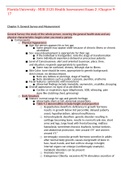Exam (elaborations)
Florida University : NUR 3125 Health Assessment Exam 2 /Chapter 9-17,100% CORRECT
- Course
- Institution
Florida University : NUR 3125 Health Assessment Exam 2 /Chapter 9-17 Chapter 9: General Survey and Measurement General Survey: the study of the whole person, covering the general health state and any physical characteristics; begins when you meet a person ● Components ○ Physical Appea...
[Show more]



